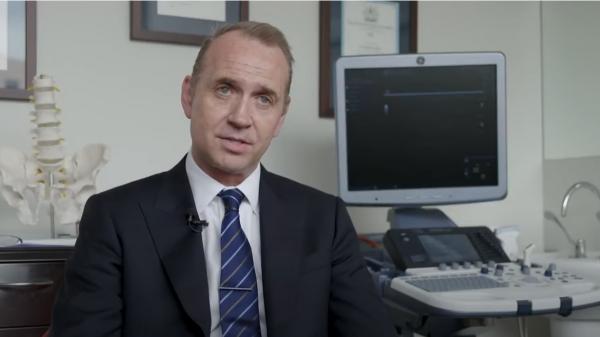nr-axSpA explained
View transcript
Non-radiographic axial spondyloarthropathy is a term that rheumatologists use to describe a condition where there is inflammation in the spine and joints. If we pull that term apart, spondyloarthropathy, spondylo means spine, arthropathy means joints, so that means inflammation in the spine and joints. The axial part means, in this condition, it’s predominantly involving the skeleton, often the sacroiliac joints, giving lower back pain. Non-radiographic refers to the fact that it damages slowly, and so we don’t often see changes on x-ray.
The people typically affected by this type of arthritis are young people. These are people from the age of 18 through to 35, who usually are moving around from doctor to doctor trying to find an answer for their symptoms. The symptoms that patients experience are overwhelmingly stiffness. They start to experience stiffness in the morning, unexplained, often gets better with activity. They’re often woken at night by pain, alternating from buttock to buttock, that makes them get out of bed and walk around.
Unfortunately, the journey for many of these patients is prolonged. We know that there’s a delay in diagnosis of anywhere up to eight years, which is a long time to experience these symptoms without an answer. The journey, unfortunately, is because of a, I guess, a lack of awareness of the condition, that these symptoms are put down to growing pains, sporting injuries, mechanical problems within the spine. Even when people have x-rays and they see professionals, sometimes the diagnosis is missed.
As a rheumatologist, when I see someone who I suspect has a spondyloarthropathy I’m asking them first about the history of their symptoms, and I’m listening for those things that I talked about, the new onset morning stiffness or the morning stiffness that’s been there for quite while, the back pain, the peripheral joint symptoms, fatigue. And then as well as the history, I’ll use examinations to see if there is reduction in range of motion of the spine, and then I’ll move to investigations, so I’ll do blood tests, and I’ll usually do an MRI scan to help me diagnose the condition.
The commonest questions I’m asked when I give someone the diagnosis of a spondyloarthropathy is number one, am I going to be disabled? I’m able to answer that no, with modern therapy, we can stop damage occurring and allow people to lead normal, functional lives. That’s our bar, and I try to set that with people early, so that they know that we want to get rid of the fatigue. We want to get rid of the pain, and we’re going to use different medications to do that.
When I’m speaking to someone about how we’re going to treat their condition, I use three broad headings. Diet, exercise, and medicine. Let’s talk about medicine first, because that’s what I do primarily. The medicine is an injection which is given by an EpiPen, usually once a fortnight or once a month. That leads to rapid improvement in most patients in their symptoms. It is important the patients are complaint with that medication to ensure they get the best result.
Exercise remains always important. Stretching exercises are often given, but we encourage people to maintain their favoured aerobic exercise. And finally, diet. A lot of people ask about diet. I must say that there’s no proven diet that fixes this condition, but eating a healthy diet and also with things added to that diet like omega-3 fatty acids certainly facilitates what I’m doing with the medication.
My message to people is simple. Number one is keep searching if you’ve got symptoms. Keep pushing, because I’ve had many people who after eight years of trying to find a diagnosis, we’ve eventually got one and been able to get them to effective therapy. The second is don’t be afraid. Be optimistic. The outcome for these conditions with modern therapy is just excellent. And the third thing is work with your doctor and health team. Share your fears, share your symptoms, share your concerns. The treatment goal is to, obviously, to get people better, to get rid of the symptoms, allow them to return to normal, functional lives.













